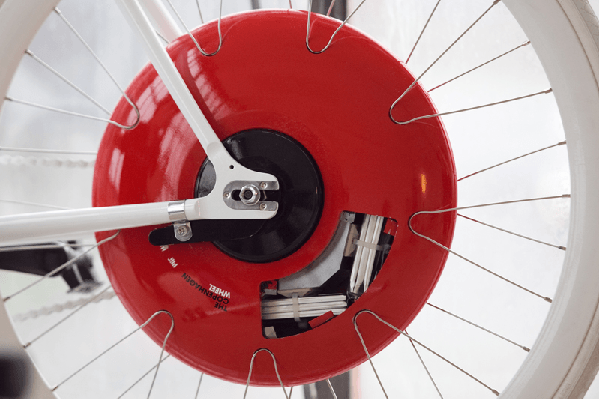You might expect the front wheel of your bicycle to contain a system of internal gears that capture and maximize the kinetic energy you expend pedaling and braking to help you up hills or over long stretches. And that’s exactly what the Copenhagen Wheel does. You probably don’t expect that same wheel to act as a two-way communication device, charting how many miles you’ve ridden and comparing that to your heart rate, fitness goals and exercise and diet regimen (allowing you to eat ice cream if you ride two more miles, for example).
Certainly no one expects the wheel of a bike to perform as a sewing machine engine, or like a mobilized Twitter account, keeping track of traffic conditions, road blocks or detours, as well as pollution levels like sulfur dioxides, nitrogen oxides and particulates from combustion-engine vehicles, factories and power plants. Yet those are precisely the kinds of things the wheel, from the MIT Senseable City Lab via the Department of Urban Studies and Planning, does—providing a wealth of information that crowd-sharing platforms can use to aggregate data via electronic communications or the Web in order to arrive at a more complete and comprehensive evaluation of transportation infrastructures and such urban anomalies as the heat-island effect.

Partnered with such environmentally savvy corporations as AT&T, General Electric, IBM, SNCF, British Telecom and Volkswagen, and working with leading global cities like Copenhagen, Florence, Seattle and Singapore, the MIT Senseable City lab is aiming at the kind of crowd-sourcing that allows urban planners to evaluate, in real terms and in real time, how a city’s infrastructure and build out will influence its inhabitants, for good or ill.
Unveiled as a mockup at the United Nations Climate Conference in 2009, the fully adaptable and interchangeable Copenhagen Wheel has met with considerable interest from city planners around the world. The next step for the wheel is construction of several more sets of prototypes that improve on both the electronics and control systems. Then the Copenhagen Wheel 2.0 will have a “pre-series commercial launch” during the third quarter of this year.
The wheel itself, at an average cost of $600, will then become available through licensed retailers in each country. This, in turn, will hopefully lead to a wider uptake that reduces the use of combustion engines, particularly inside cities, and inspires urban planners to think of the atmosphere and not the freeway interchange as a major city attraction. Who knows? It might even power your refrigerator!